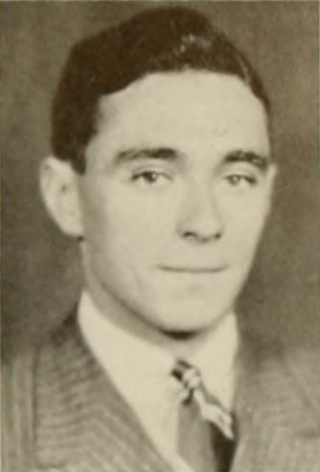Related Research Articles
Educational psychology is the branch of psychology concerned with the scientific study of human learning. The study of learning processes, from both cognitive and behavioral perspectives, allows researchers to understand individual differences in intelligence, cognitive development, affect, motivation, self-regulation, and self-concept, as well as their role in learning. The field of educational psychology relies heavily on quantitative methods, including testing and measurement, to enhance educational activities related to instructional design, classroom management, and assessment, which serve to facilitate learning processes in various educational settings across the lifespan.

Jerome Seymour Bruner was an American psychologist who made significant contributions to human cognitive psychology and cognitive learning theory in educational psychology. Bruner was a senior research fellow at the New York University School of Law. He received a BA in 1937 from Duke University and a PhD from Harvard University in 1941. He taught and did research at Harvard University, the University of Oxford, and New York University. A Review of General Psychology survey, published in 2002, ranked Bruner as the 28th most cited psychologist of the 20th century.
Instructional scaffolding is the support given to a student by an instructor throughout the learning process. This support is specifically tailored to each student; this instructional approach allows students to experience student-centered learning, which tends to facilitate more efficient learning than teacher-centered learning. This learning process promotes a deeper level of learning than many other common teaching strategies.
Situated cognition is a theory that posits that knowing is inseparable from doing by arguing that all knowledge is situated in activity bound to social, cultural and physical contexts.
The cognitive revolution was an intellectual movement that began in the 1950s as an interdisciplinary study of the mind and its processes, from which emerged a new field known as cognitive science. The preexisting relevant fields were psychology, linguistics, computer science, anthropology, neuroscience, and philosophy. The approaches used were developed within the then-nascent fields of artificial intelligence, computer science, and neuroscience. In the 1960s, the Harvard Center for Cognitive Studies and the Center for Human Information Processing at the University of California, San Diego were influential in developing the academic study of cognitive science. By the early 1970s, the cognitive movement had surpassed behaviorism as a psychological paradigm. Furthermore, by the early 1980s the cognitive approach had become the dominant line of research inquiry across most branches in the field of psychology.

The Educated Mind: How Cognitive Tools Shape Our Understanding is a 1997 book on educational theory by Kieran Egan.
John Robert Anderson is a Canadian-born American psychologist. He is currently professor of Psychology and Computer Science at Carnegie Mellon University.

Reuven Feuerstein was a Romanian-born Israeli clinical, developmental, and cognitive psychologist, known for his theory of intelligence. Feuerstein is recognized for his work in developing the theories and applied systems of structural cognitive modifiability, mediated learning experience, cognitive map, deficient cognitive functions, learning propensity assessment device, instrumental enrichment programs, and shaping modifying environments. These interlocked practices provide educators with the skills and tools to systematically develop students’ cognitive functions and operations to build meta-cognition.
Evolutionary educational psychology is the study of the relation between inherent folk knowledge and abilities and accompanying inferential and attributional biases as these influence academic learning in evolutionarily novel cultural contexts, such as schools and the industrial workplace. The fundamental premises and principles of this discipline are presented below.
Frank Smith (1928-2020) was a Canadian psycholinguist recognized for his contributions in linguistics and cognitive psychology. He was an essential contributor to research on the nature of the reading process together with researchers such as George Armitage Miller, Kenneth S. Goodman, Paul A. Kolers, Jane W. Torrey, Jane Mackworth, Richard Venezky, Robert Calfee, and Julian Hochberg. Smith and Goodman are founders of whole language approach for reading instruction. He was the author of numerous books.
Ron Sun is a cognitive scientist who made significant contributions to computational psychology and other areas of cognitive science and artificial intelligence. He is currently professor of cognitive sciences at Rensselaer Polytechnic Institute, and formerly the James C. Dowell Professor of Engineering and Professor of Computer Science at University of Missouri. He received his Ph.D. in 1992 from Brandeis University.
Leonard Katz (1938–2017) was an American experimental psychologist, born in Boston, Massachusetts. He was a professor of psychology at the University of Connecticut (1965–2006) and then professor emeritus until 2017. He was a Fellow of the American Association for the Advancement of Science and the Association for Psychological Science.

Charles Ransom Gallistel is an Emeritus Professor of Psychology at Rutgers University. He is an expert in the cognitive processes of learning and memory, using animal models to carry out research on these topics. Gallistel is married to fellow psychologist Rochel Gelman. Prior to joining the Rutgers faculty he held positions at the University of Pennsylvania, where he was chair of the psychology department and Bernard L. & Ida E. Grossman Term Professor, and at the University of California, Los Angeles.

Charles Bazerman is an American educator and scholar. He was born and raised in New York. He has contributed significantly to the establishment of writing as a research field, as evidenced by the collection of essays written by international scholars in Writing as A Human Activity: Implications and Applications of the Work of Charles Bazerman. Best known for his work on genre studies and the rhetoric of science, he is a Professor of Education at the University of California, Santa Barbara, where he also served as Chair of the Program in Education for eight years. He served as Chair of the Conference on College Composition and Communication, delivering the 2009 CCCC Chair's Address, "The Wonders of Writing," in San Francisco, California. He is the author of over 18 books, including Shaping Written Knowledge, Constructing Experiences, The Languages of Edison’s Light, A Theory of Literate Action, and a Rhetoric of Literate Action. He also edited over 20 volumes, including Textual Dynamics of the Profession, Writing Selves/Writing Societies, What Writing Does and How it Does It, as well as the Handbook of Research on Writing and the two series Rhetoric, Knowledge and Society and Reference Guides to Rhetoric and Composition. He also wrote textbooks supporting the integration of reading and writing that have appeared in over 30 editions and versions including The informed writer: Using sources in the disciplines, The Informed Reader, and the English Skills Handbook.
Metalinguistic awareness, also known as metalinguistic ability, refers to the ability to consciously reflect on the nature of language. The concept of metalinguistic awareness is helpful in explaining the execution and transfer of linguistic knowledge across languages. Metalinguistics expresses itself in ways such as:
Katherine Nelson was an American developmental psychologist, and professor.
Concept-Oriented Reading Instruction (CORI) was developed in 1993 by Dr. John T. Guthrie with a team of elementary teachers and graduate students. The project designed and implemented a framework of conceptually oriented reading instruction to improve students' amount and breadth of reading, intrinsic motivations for reading, and strategies of search and comprehension. The framework emphasized five phases of reading instruction in a content domain: observing and personalizing, searching and retrieving, comprehending and integrating, communicating to others, and interacting with peers to construct meaning. CORI instruction was contrasted to experience-based teaching and strategy instruction in terms of its support for motivational and cognitive development.

The Department of Psychology at Harvard University is an academic department in Cambridge, Massachusetts, United States, that is part of the Harvard Faculty of Arts and Sciences. The department offers bachelor's, master's and doctorate degrees in psychology. Current research at the department focuses on clinical, cognitive, developmental, and social psychology. Notable psychologists that have been affiliated with the department include William James, B. F. Skinner, Gordon Allport, Jerome Bruner, George Miller, and Henry Murray, among others. The department ranks as one of the top psychology departments in the United States and the world.
Danielle S. McNamara is an educational researcher known for her theoretical and empirical work with reading comprehension and the development of game-based literacy technologies. She is professor of psychology and senior research scientist at Arizona State University. She has previously held positions at University of Memphis, Old Dominion University, and University of Colorado, Boulder.

Professor John Downing, an educational psychologist, proposed the cognitive clarity theory of learning to read in a paper which he presented to the annual meeting of the United Kingdom Literacy Association between the 23rd and 28th of July, 1971.
References
- ↑ Astington, Janet; Harris, Paul L.; Olson, David R., eds. (1988). Developing Theories of Mind. Cambridge University Press. ISBN 9780521354110.
- ↑ Astington, Janet, ed. (2000). Minds in the making: Essays in honor of David R. Olson. Oxford, UK: Blackwell.
- ↑ Vygotsky, L. S. (1987). The collected works of L. S. Vygotsky. R.W. Rieber & A. S. Carton, eds. New York, NY: Plenum.)
- ↑ Harris, R. (2009). Rationality and the literate mind. London: Routledge.
- ↑ Linell, P. (2005). The written language bias in linguistics. London: Routledge.
- ↑ Brandom, R. (2000). Articulating reasons: An introduction to inferentialism. Cambridge, MA: Harvard University Press.
- ↑ Bruner, J. S. (1960). The process of education. Cambridge, MA: Harvard University Press.
- ↑ McCallister, C. (2011). Unison Reading: Socially Inclusive Group Instruction for Equity and Achievement. Thousand Oaks, CA: Corwin Press.